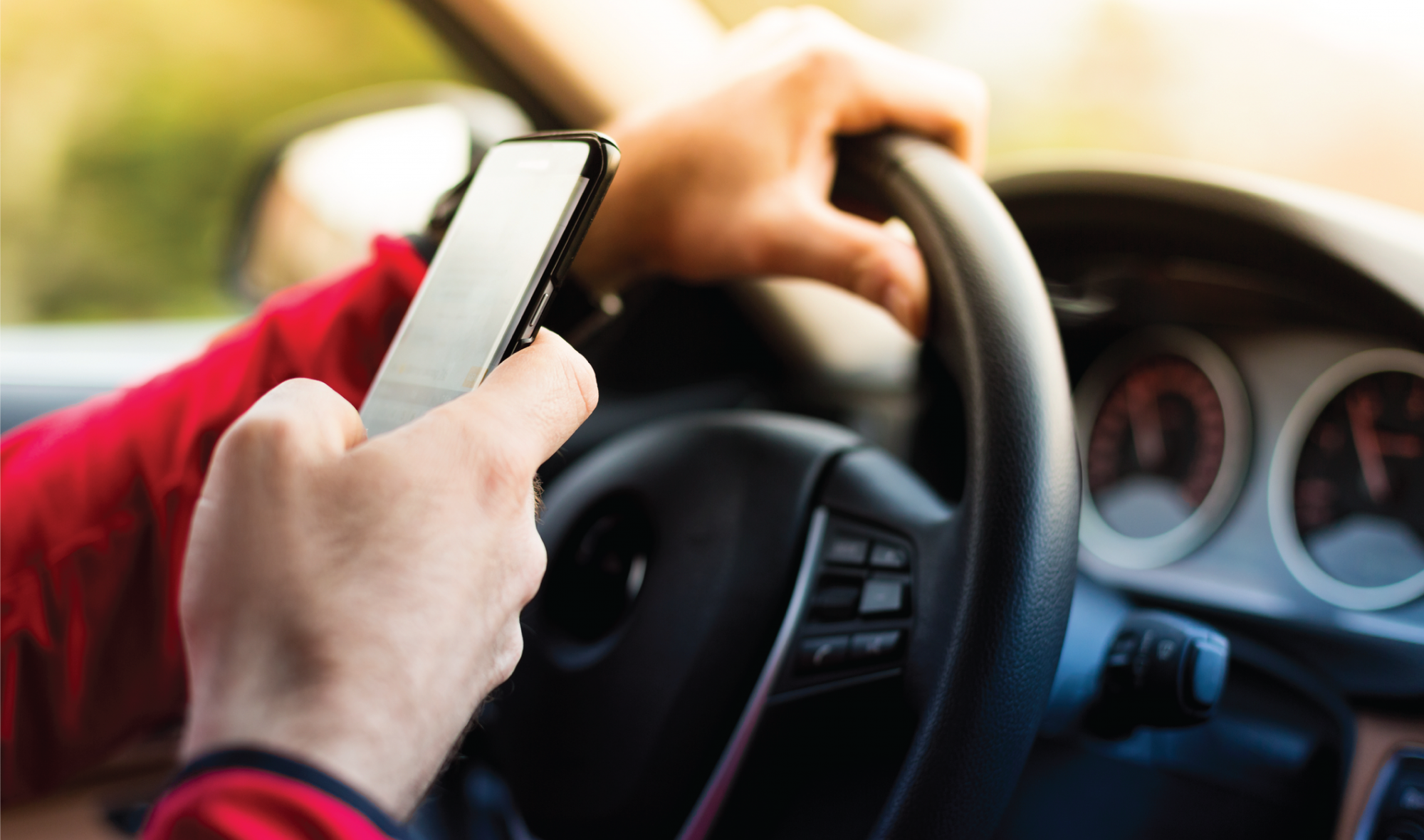
Distracted Driving is Hazardous Driving
From laws to training and technology: how to improve traffic safety
Every year, thousands of people are killed or injured in motor vehicle crashes that involve distracted drivers — often, people using their cell phones, tablets, e-readers, gaming consoles and other mobile devices while driving. According to the National Highway Traffic Safety Administration (NHTSA), distracted driving takes the lives of about 3,000 people each year, and injures another 400,000. One out of every four vehicle collisions in the United States is caused by texting and driving. About 13% of all fatal crashes involving distracted driving also feature some sort of cell phone use, according to the National Safety Council. Studies using driving simulators, instrumented vehicles (vehicles with sensors and real-time recording of driver behavior), and crash data have demonstrated that texting, dialing, reading, and checking email are serious safety threats that lead to crashes and death.
While none of this is news, the problem persists. According to the federal government’s National Occupant Protection Use Survey, or NOPUS, conducted by NHTSA, talking on mobile phones while driving declined by 1.8% from 2009 to 2018, but the use of phones and other hand-held devices for texting and browsing social media increased. The survey also found that mobile phone use is highest among younger drivers (ages 16–24) and female drivers. Another NHTSA survey on distracted driving attitudes and behaviors found that 28% of drivers “always” or “almost always” answered their phones while driving and 58% said they would continue to drive while talking on the phone. In a third study by ZenDrive Research, which analyzed 3 million drivers who collectively took 570 million trips (adding up to 5.6 billion miles) over three months, the data showed that drivers use their phones on more than 80% of trips. Actual device use, moreover, might be higher than some studies report, because of the so-called “lie factor” in traffic safety research where drivers tend not to admit to illegal or socially unacceptable behaviors.
State Laws on Device Use While Driving
What can be done to combat distracted driving? Many states have passed laws on using cell phones and texting while driving, as summarized in Figure 1. The most common intervention is a ban on texting while driving. Forty-seven states and three territories have such bans, and some existing evidence suggests they are effective. In these states, for example, rates of texting among high school-aged drivers are lower today than before the bans were implemented. Eighteen states and one territory go further and ban hand-held use entirely for drivers, while another four states have limited bans on hand-held use. In many states, however, there are no restrictions on using hand-held devices, beyond prohibitions on texting.
Figure 1: Summary map of state laws on device use while driving
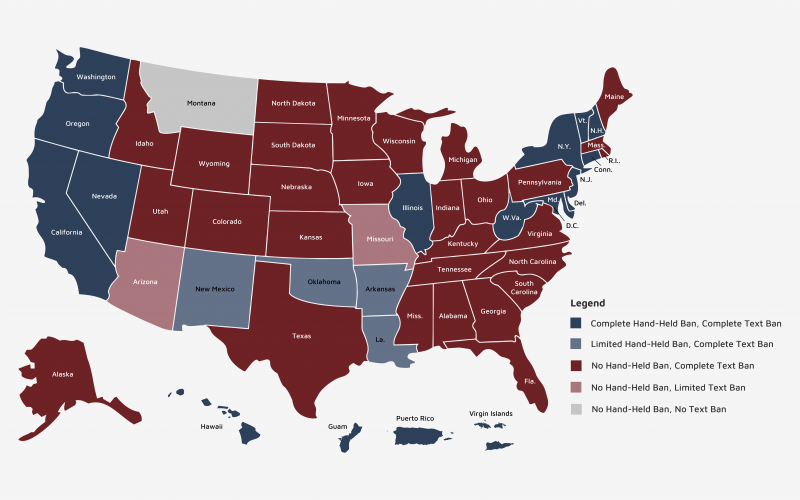
In 2013, Hawaii passed a law banning the use of hand-held cell phones while driving. The University of Hawaii has collected data on hand-held device use by drivers since 2003. The university collects these data by observing actual vehicles and trying to discern if a driver is using a device. This method is not directly comparable to the self-reported survey data we mentioned above (there is a big difference between a driver admitting to using a device at some point during a trip, and an observer happening to see that use occur), and the estimates of use are as a consequence much lower. Figure 2 shows those estimates, for cell phone use while driving, from 2003 to 2017. Device use appears to have fluctuated over time, between a high of 4.7% in 2006 to a low of 1.6% in 2017.
To better understand the nature and extent of device use while driving, we recently conducted a nationwide survey, where respondents were asked several questions about their use of hand-held devices while driving. We sent our survey to more than 5,000 email addresses across the U.S., to people interested in transportation topics, traffic safety, public policy, risk management, and education. We also distributed it through social media platforms, including Facebook, Twitter, and LinkedIn, to reach a broad national audience. The group we targeted, because they work in fields related to transportation, safety and risk, is obviously different from the larger driving population, so our results are not directly comparable to NOPUS. It is possible, however, that our sample might be more aware than the general public of the hazards associated with device use, which suggests that our findings may understate the actual prevalence of device use in the population.
There were a total of 337 respondents across 43 states, plus Washington, D.C., and Puerto Rico (all except Vermont, West Virginia, Arkansas, Wisconsin, North Dakota, Montana, and Idaho). Half the respondents identified as male, and just under half (46%) as female (the rest did not indicate gender). The survey included respondents across different age groups and socioeconomic backgrounds, and who drive various types of vehicles (car, van, pickup truck).
Figure 2. Observed cell phone use while driving, Hawaii, 2003-2017
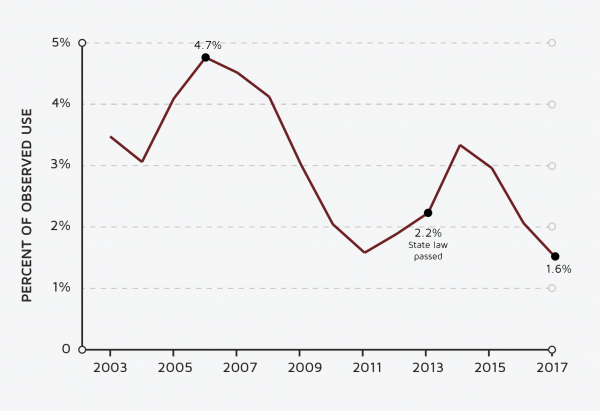
In the survey, 63% of respondents reported generally using a hand-held device — which included phones, tablets and other devices — while driving, and 59% reported using a cell phone specifically. Twenty-eight percent reported using a hands-free phone, while 4% reported using other types of hand-held devices (see Figure 3). Recall again that these self-reported rates may well be underestimated.
Figure 3. Device use reported in survey
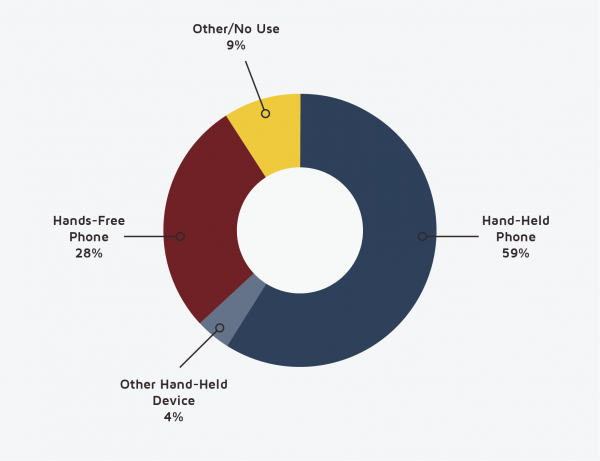
We also found that young and middle-aged drivers use hand-held devices more than older adults. Fifty-seven percent of drivers 25 years and younger use hand-held devices while driving, similar to the 60% rate of use for those 26 to 64 years of age. Just 38% of those over 65, however, reported using a device while driving. About a third of young drivers (18- to 25-year-olds) and older adults (over 65 years old) use hands-free communication devices, 36%, and 33%, respectively (see Figure 4).
Our study also found more males (59%) use hand-held devices than females (57%), which differs from other published research, such as NOPUS.
Figure 4. Mobile device use while driving by age groups
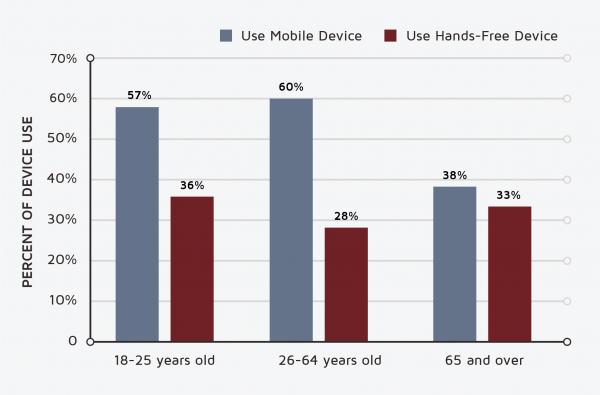
Respondents from states that ban text messaging or hand-held device use were, compared to respondents in other places, less likely to report such use.
Nevertheless, even in states with bans or restrictions, 52% of respondents admitted to using a hand-held phone while driving. Even in states with bans on text messaging while driving, 46% of the drivers in the study admitted to engaging in that activity. States with bans on text messaging have the highest use of hands-free devices.
Device Use
Of the 206 respondents using devices while driving, the most frequent uses were answering or making phone calls, navigating, texting, listening to music, checking email, browsing the internet, watching videos, and playing games as shown in Figure 5.
Figure 5. Frequent uses of mobile devices while driving
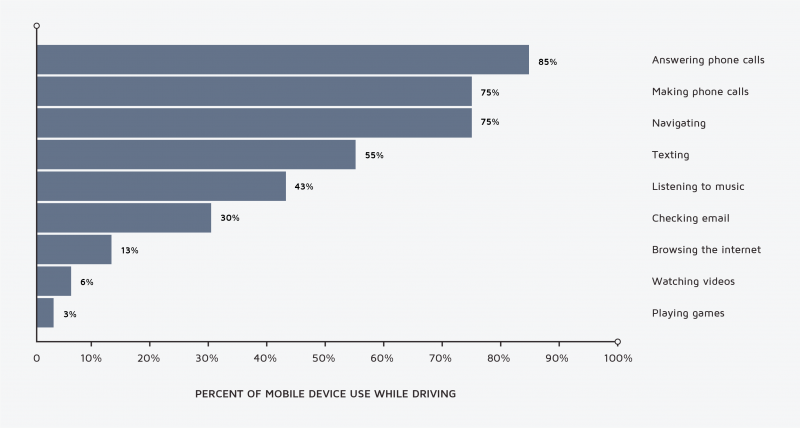
Safety and Enforcement
Fifty-one percent of survey respondents reported they felt unsafe or very unsafe riding with a driver using a hand-held device, yet 60% of respondents felt that it was unlikely that a motorist would be stopped and cited for using a hand-held device while driving — only 5% of drivers reported actually receiving a ticket. Seventy-seven percent of the respondents agreed there should be stricter enforcement.
Our survey included a question about crash involvement. Among the 323 respondents who answered this question, 15% had been in a crash within the past three years. Of those, 60% reported currently using hand-held devices while driving. Among respondents who were not in any crashes, 57% admitted to using a device while driving. While there is a slight association between self-reported crashes and device use while driving, no one admitted to using a device at the time of the crash.
Overall, the survey respondents supported increased police enforcement of laws prohibiting hand-held device use while driving. However, detecting device use in vehicles is difficult. State law enforcement personnel need increased training to spot, record, and cite device use by drivers. To enhance enforcement, states would need to increase penalties, and provide further education on the hazards of distracted driving.
Nevertheless, technology may provide some solutions. For example, researchers at the University of Hawaii are developing methods to automate the detection of hand-held device use by drivers while driving. High-resolution cameras, artificial intelligence software libraries, and machine vision technologies are used to study hand-held device use by drivers.
Reducing Distracted Driving
To prevent crashes and improve road safety, states need to more properly address the hazards associated with distracted driving. Doing this will require better research into how drivers perceive the risks and benefits of using hand-held or hands-free devices while driving — including social or work-related pressures to make calls or send texts. Manufacturers of hand-held devices and communications and Internet service providers share responsibility for educating drivers about the increased risks of crashes due to driving and texting or talking. Research is also needed on the development and evaluation of innovative strategies to help drivers avoid device use while driving.
One such strategy is expanded support training and education to reduce risky behaviors. Between April 2010 and April 2011, NHTSA conducted a demonstration project in Hartford, Connecticut, and Syracuse, New York, using high-visibility enforcement to discourage the use of hand-held cell phones. The enforcement campaign resulted in a drop in observed cell phone use from 6.8% to 2.9% in Hartford and from 3.7% to 2.5% in Syracuse. Dialing and texting rates dropped from 3.9% to 1.1% in Hartford and from 2.8% to 1.9% in Syracuse.
Strategies to reduce device use while driving should target all potential distractions from devices to car technologies. For example, heads-up information from mobile phones on dash-mounted displays to support navigation and other tasks can reduce the risks of distracted driving crashes. Bluetooth and other communications technologies in vehicles can reduce the need for hand-held devices, but may also divert attention from driving and the roadway environment, causing distraction. Better integration of these technologies with warning and collision avoidance systems to inform drivers who are veering off course can also help reduce crashes. Blocking technologies — pre-installed on the device or added as software — to prevent calls or texts from moving vehicles may further reduce crash risk.

Strategies to reduce device use while driving should target all potential distractions from devices to car technologies.

Through a collaborative approach combining research, education, training, and partnerships between safety advocates, transportation agencies, law enforcement, industry, and device manufacturers, we can all reduce distracted driving and improve traffic safety.